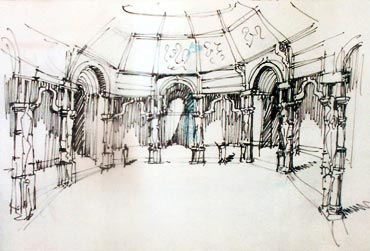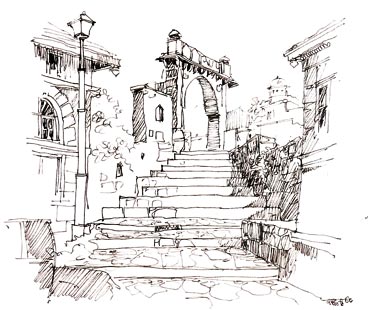 | « Back to article | Print this article |
Pix: Can you recognise these movie sets?
Designing grand sets for Bollywood's superstars is cakewalk for art director Sabu Cyril. A four-time National Award winner, he has created sets in films like Om Shanti Om, Endhiran, Billu, Main Hoon Na and regional films like Thenmavin Kombath and Kalapani. He has worked in about 50 films in Hindi, Malayalam, Tamil and Telugu.
Sabu shares some of his terrific sketches with Patcy N, and talks about his films, including Karan Johar's upcoming Agneepath, in the first part of this special.
'Art direction was quite accidental'
How did a graphics designer become an art director?
It was quite accidental. I had my own agency and I was freelancing. A college friend was art director for a Malayalam film Iyer The Great, but got the chance to direct another film and so recommended my name to replace him.
I worked for seven days on the film, my work was appreciated and I was offered a second film. It took seven months to complete that film and by then my agency was defunct and I had to close down. The payment was much less but I enjoyed working on the film.
Bharathan saw the sets of Iyer The Great and was impressed and gave me a film. Amaram is my first film as art director. I got five other film offers while doing Amaram and after that there was no looking back.
'Shankar had so much faith in me that he did everything consulting me'
Don't you require any formal training to be an art director?
You don't require much training.
As a kid I was an all-rounder, I wanted to learn and know everything. I loved mechanics, and all these things helped me become an art director. Whatever I have learnt, I have learnt being on different films and because of my reading habit. Therefore, directors trusted me with their films.
Shankar (director of Robot) had so much faith in me that he did everything consulting me; I was part of every discussion.
'Period films are easier to create'
What is more interesting to create, a period drama or a futuristic film?
Period films are easier but you have to put in lots of effort to research and then recreate.
For futuristic films, you should know science and technology, what theme you are handling, if it is robotics then you have to think of how robotics will advance in another 15 years, like whether cars will fly, you have to imagine lots of things.
'Today, art direction has become so easy because of the technology'
What major changes have taken place in the film industry, particularly in your field, over the years?
I am very lucky that I was there in the black and white period helping my uncle on a Telugu film before becoming an art director. I helped my uncle in special effects and did glass matte painting and today it is digital matte painting. Very few people know both the things.
Today, art direction has become so easy because of all the technology. Designing now can be done on a computer -- we used to do everything with paper and pencil. Now I just do scribbles on paper and my assistants take that and do the work on a computer because I don't have the patience to sit at a computer. But it has become too mechanical and I like to give it an artistic touch so I draw it.
We should use technology but it should not take away from our creative judgment.
'The new Agneepath's script has been changed'
Your job is creative and so is the job of the film's director and you have to carry out his ideas, so how does it work?
Priyan (Priyadarshan) once said that an art director is like my hand and the cameraman is like my eyes. There are three people who work together to bring you one thing: the director, cameraman and the art director.
A director tells you the scene you have to imagine, for example, for Agneepath the director told me the story and the things that he needs, like he told me we need an island, which should look isolated and away from Mumbai.
Immediately I suggested Diu because it is an apt location. It was difficult terrain to shoot in but it would be more difficult making the sets like that. After that I created the village and the house or whatever was needed in the film.
When you work on projects like Agneepath which have already been created years ago, does it still challenge you?
I don't get influenced. Every film demands certain things. This Agneepath's script has been changed, and a lot has been based on that. Even the village was based on present conditions.
If the same Agneepath was made in Malayalam or Tamil, I would have suggested a different place in Kerala or Tamil Nadu, and not Diu because it would have closer.
We take references from different places but we make things according to the film's characters. When I worked on Kaalapani, I used the memory of the tea estate that I grew up in, where Englishmen made the staff. Observation is part of our job.
For Gardish, you made Dhobi Ghat in Chennai. What is easier: copying a city that already exists or making a new village altogether?
Making a place that is not made altogether because you have to use more imagination. I am a huge fan of James Bond films and futuristic films. I created a song in Billu called Love Mera Hit Hit, which is futuristic where Shah Rukh Khan comes from another planet.
At the same time, the whole village is a set in Billu. I made it in Kamalistan studios.





